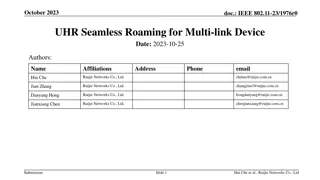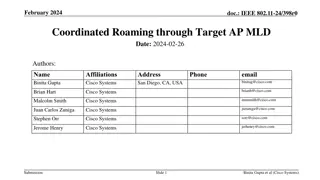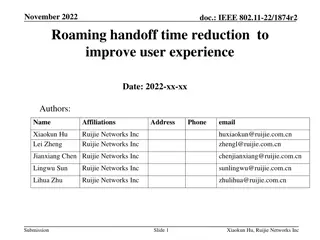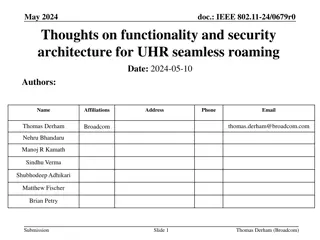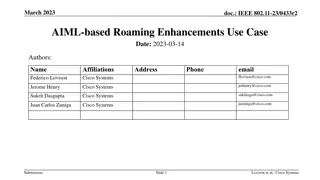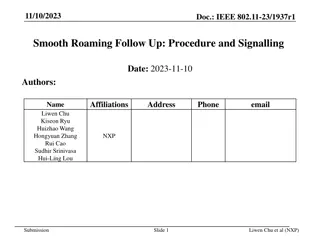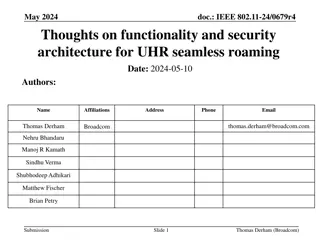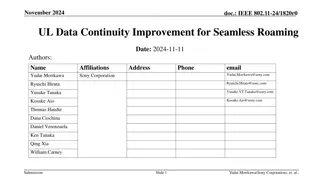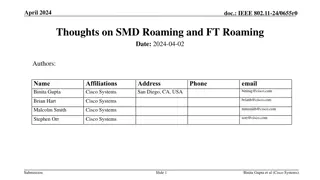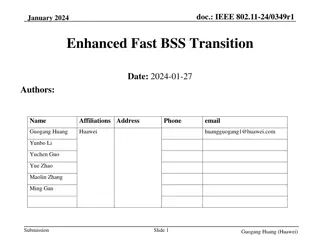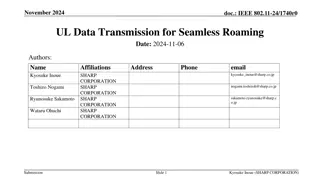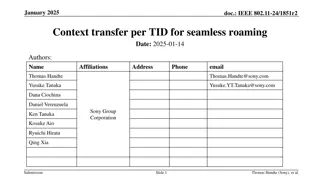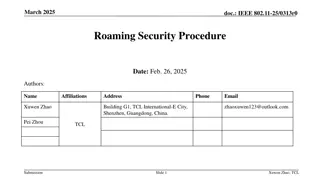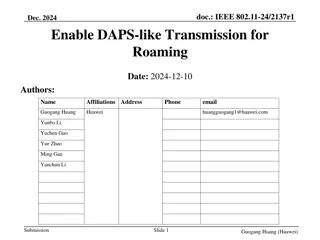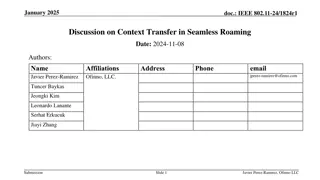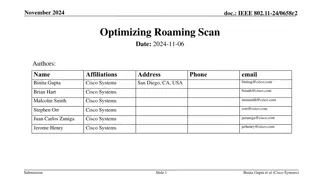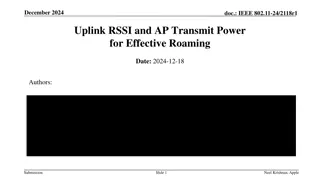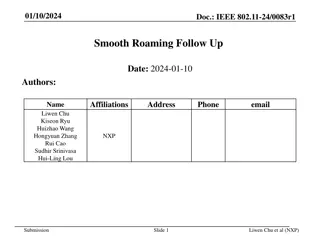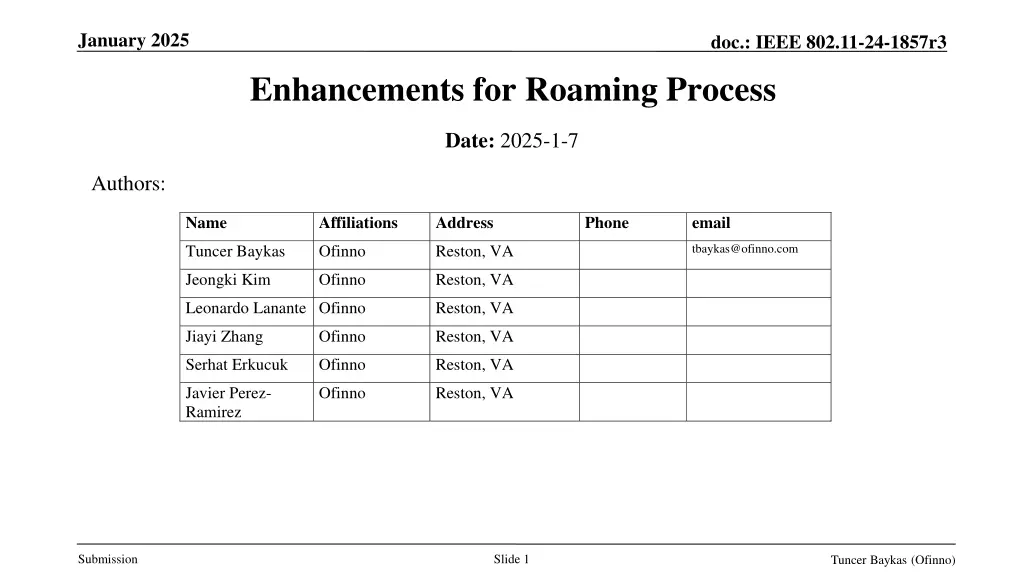
IEEE 802.11-24-1857r3 Enhancements for Roaming Process
Explore the enhancements proposed for the roaming process in IEEE 802.11-24-1857r3, focusing on aspects like draining uplink data, uplink data transmission after roaming requests, and innovative proposals for handling UL data during roaming. Discover the detailed discussions and suggestions brought forward by the authors regarding seamless/improved roaming techniques.
Download Presentation

Please find below an Image/Link to download the presentation.
The content on the website is provided AS IS for your information and personal use only. It may not be sold, licensed, or shared on other websites without obtaining consent from the author. If you encounter any issues during the download, it is possible that the publisher has removed the file from their server.
You are allowed to download the files provided on this website for personal or commercial use, subject to the condition that they are used lawfully. All files are the property of their respective owners.
The content on the website is provided AS IS for your information and personal use only. It may not be sold, licensed, or shared on other websites without obtaining consent from the author.
E N D
Presentation Transcript
January 2025 doc.: IEEE 802.11-24-1857r3 Enhancements for Roaming Process Date: 2025-1-7 Authors: Name Affiliations Address Phone email tbaykas@ofinno.com Tuncer Baykas Ofinno Reston, VA Jeongki Kim Ofinno Reston, VA Leonardo Lanante Ofinno Reston, VA Jiayi Zhang Ofinno Reston, VA Serhat Erkucuk Ofinno Reston, VA Javier Perez- Ramirez Ofinno Reston, VA Submission Slide 1 Tuncer Baykas (Ofinno)
January 2025 doc.: IEEE 802.11-24-1857r3 Introduction Roaming is one of the main topics discussed by the TGbn group. Multiple presentation have focused on how to enable seamless/improved roaming [1-12]. In this presentation, some of the enhancements for the roaming is discussed. Submission Slide 2 Tuncer Baykas (Ofinno)
January 2025 doc.: IEEE 802.11-24-1857r3 Draining Uplink Data by STA before Roaming In some contributions, it is suggested that the STA should drain the Uplink Data before roaming execution [2,5]. Roaming Preparation Roaming Execution Target AP Dyn Context Transfer, DS Mapping Change Static Context Transfer R Notify R resp. Serving AP Link Del. UL Data Buffered R Notify R Req. STA Submission Slide 3 Tuncer Baykas (Ofinno)
January 2025 doc.: IEEE 802.11-24-1857r3 Uplink Data Transmission after Roaming Request If the buffer of the STA is full or there is a heavy traffic in the network, draining the UL DATA may take a considerable time, thus delaying the roaming process. In [14, 15] it is suggested, there could be cases where UL transmission could be allowed for special cases. Roaming Preparation Roaming Execution Target AP Dyn Context Transfer, DS Mapping Change Static Context Transfer R Notify R resp. Serving AP Link Del. UL Data UL Data R Notify R Req. STA Submission Slide 4 Tuncer Baykas (Ofinno)
January 2025 doc.: IEEE 802.11-24-1857r3 Proposal 1 Providing Total Size for UL Data When a STA decides to roam, STA requests for a total size of the AP-MLD for UL draining and transmits UL Data according to the information it receives. Roaming Preparation Roaming Execution Target AP Dyn Context Transfer, DS Mapping Change Static Context Transfer R Resp. + UL Data R Notify Size Serving AP UL DATA R Req. + Link Del. UL Data UL Data Buffered Selected R Notify Size STA Submission Slide 5 Tuncer Baykas (Ofinno)
January 2025 doc.: IEEE 802.11-24-1857r3 Proposal 2 Providing Duration for UL Data After receiving roaming request, AP-MLD may indicate a duration for STA to transmit UL Data. Roaming Preparation Roaming Execution Target AP Dyn Context Transfer, DS Mapping Change Static Context Transfer R resp. + duration R Notify UL Serving AP Link Del. UL Data UL Data R Notify R Req. STA UL duration Submission Slide 6 Tuncer Baykas (Ofinno)
January 2025 doc.: IEEE 802.11-24-1857r3 QoS Requirements and Roaming For many applications QoS requirements can dynamically change E.g. changes to throughput and/or latency requirement based on events/triggers experienced It is proposed enhancements to support dynamic updates to QoS requirements for flows, to enable efficient scheduling for UL and DL resources by the AP. [13] STAs may request roaming not only for keeping connection but to satisfy new QoS requirements. Submission Slide 7 Tuncer Baykas (Ofinno)
January 2025 doc.: IEEE 802.11-24-1857r3 Current QoS exchange in 802.11be The network uses Stream classification service (SCS) descriptor with QoS Characteristics element to indicate its requirements. There is a change request for each stream qualification service. Note A QoS Characteristics element provided by a non-AP EHT STA is used by a receiving EHT AP to facilitate the creation of a schedule for contention based channel access (EDCA) or MU operation. How the AP uses the information provided by the non-AP STA QoS Characteristics element that do not have corresponding normative requirements is beyond the scope of the standard. Submission Slide 8 Tuncer Baykas (Ofinno)
January 2025 doc.: IEEE 802.11-24-1857r3 Proposal 1 The roaming is initiated with a roaming notification frame by the STA. Serving AP sends all SCS QoS requirements to the Target AP Target AP indicates which SCS QoS, Target AP can support, if Target AP cannot support all QoS s Serving AP informs the STA. If the STA decides to continue with the roaming process, STA sends a roaming request. Roaming Preparation Roaming Execution Target AP Dynamic Context Context Transfer Transfer QoS Req. Static R Notify R Resp. Serving AP Link Del. QoS Req. R Notify R Req. STA Submission Slide 9 Tuncer Baykas (Ofinno)
January 2025 doc.: IEEE 802.11-24-1857r3 Proposal 2 The roaming is initiated with a roaming request frame by the STA with a specific SCS QoS requirement, Source AP send the SCS QoS requirements to the Target AP. If the Target AP can support QoS Requirements source AP sends a positive response. Target AP informs STA Roaming Preparation Roaming Execution Target AP Dynamic Context Context Transfer Transfer QoS Req. Static R Notify R Resp. Serving AP Link Del. QoS Req. R Notify R Req. STA Submission Slide 10 Tuncer Baykas (Ofinno)
January 2025 doc.: IEEE 802.11-24-1857r3 Conclusion In this presentation we presented two methods to improve the possible roaming process. Submission Slide 11 Tuncer Baykas (Ofinno)
January 2025 doc.: IEEE 802.11-24-1857r3 References [1] 11-24/1595r0 Scope of MAPC and Roaming Standardization (Brian Hart, Cisco Systems) [2] 11-23/2157r2 Seamless Roaming within a Mobility Domain (Binita Gupta, Cisco Systems) [3] 11-24/0396r1 Seamless Roaming within a Mobility Domain Follow Up (Binita Gupta, Cisco Systems) [4] 11-24/398r0 Coordinated Roaming through Target AP MLD (Binita Gupta, Cisco Systems) [5] 11-24/0052r0 Seamless Roaming Details (Duncan Ho, Qualcomm) [6] 11-24/0679r3 Thoughts on Functionality and Security Architecture for UHR Seamless Roaming (Thomas Der ham, Broadcom) [7] 11-23/0322r0 Improve Roaming between MLDs (Po-Kai Huang, Intel) [8] 11-23/1996r0 Improve Roaming between MLDs (Po-Kai Huang, Intel) [9] 11-24/0830r1 Improve Roaming between MLDs follow up (Po-Kai Huang, Intel) [10] 11-24/0881r0 Improving Stability during Roaming Process (Tuncer Baykas, Ofinno LLC) [11] 11-23/1897r0 Thought on Improving Roaming under Existing Architecture (Guogang Huang, Huawei) [12] 11-23/1908r0 Seamless Roaming Procedure (Yelin Yoon, LG Electronics) [13] 11-24/660r0 Dynamic QoS profiles with SCS (Binita Gupta) [14] 11-24/1740r1 UL Data Transmission for Seamless Roaming Kyosuke Inoue (SHARP) [15] 11-24/1820r1 UL Data Continuity Improvement for Seamless Roaming (Yudai Morikawa) Submission Slide 12 Tuncer Baykas (Ofinno)

